Authors note
I’m delighted to announce that Andersen Press is re-issuing my early titles in paperback, starting with this one, The Cry of the Wolf – my very first published book – on November 3rd 2011. It remains one of my favorites of mine — I still get people telling me it’s one of my best.
These early books are for a younger age range than the later ones, such as Junk and Kill All Enemies — from 11+.
I remember vividly ringing up my mum, who told me there was a letter waiting for me. She read it out over the phone. It was from Audrey Adams, editor at Andersen, telling me that they wanted to publish. At last, after years and tears of trying, I’d got someone willing to publish my book. A big day for me – from sad sap, writing loads of stuff no one ever read, to published author in one bound.
Klaus Flugge, the legendary publisher at Andersen, told me he was unable to put the book down.
“Teenage fiction. They don’t read,” he told me. “But at Andersen Press, we believe in good books!” He was as good as his word and remained loyal to my books, despite some real stingers coming his way, over many years. I’m really happy to see the paperbacks come back to their original home.
It came at a time in my life when I was really wondering if I should persevere with writing. I’d been at it for so long, with nothing to show for it, and I decided to have one real hard try. So I tried three areas – children’s fiction, radio drama and short stories. I had some success with all three, but Cry of the Wolf was shortlisted for the Carnegie medal and ended up Highly Commended. So that’s the direction I went in, and I’ve been there ever since. So – my thanks to the librarians who voted for my book! It’s a real testement to how important libraries and librarians are, not just to readers, but to writers too.
About the book
When I was a boy I always thought it a tragedy that we had exterminated alt he wolves in this country. Cry of the Wolf tells the story of the last wolf pack, somehow surviving right up to the present day. Only a few farming families know of their existence – until Ben, a farmer’s son, let’s out the secret to the Hunter, a ruthless killer who wants to be the man who kills the last English Wolf. To find out if he succeeds – you’ll have to read it and see.
The idea came to me when I was listening to a radio play called “Sister Wolf,” while I was doing the washing up. Sister Wolf was a bullying Nun, giving a girl a hard time, and I thought what a shame it was that we always use wolves to represent bad things. The very first baddy most of us come across is the Wolf, in Little Red Riding Hood or The Three Little Pigs, for instance. In Aesop he’s a murdering bully and our language is full of pithy sayings about how terrible he is. “Never Cry Wolf,” for instance, which means never pretend bad is there when it’s not. “”Beware the Wolf is sheep’s clothing” is another, meaning beware for things that are evil pretending to be good. Or, “The wolf is at the door,” – in which the wolf represents poverty.
All this is very unfair on the poor wolf, who is a good family beast, who mates for life, is a social creature – they even babysit each other – and only kills to live. IN fact, during my research it emerges that there are no known records of wolves killing human beings. It just doesn’t happen. You’re in more danger from your pet dog. Amazing! So my story is a get-back for the Wolf. In it, the wolves have names and family. But the Hunter has no name. In fact, he has the character of the wolf from Aesop – sly, greedy and murderous.
